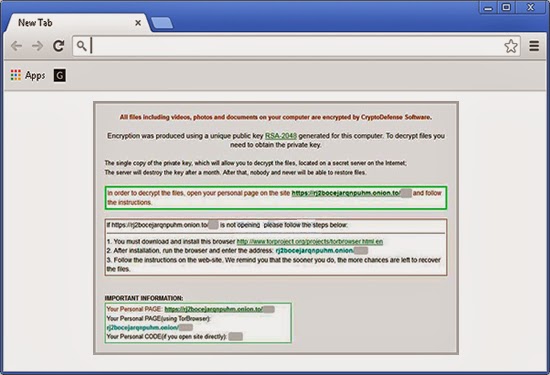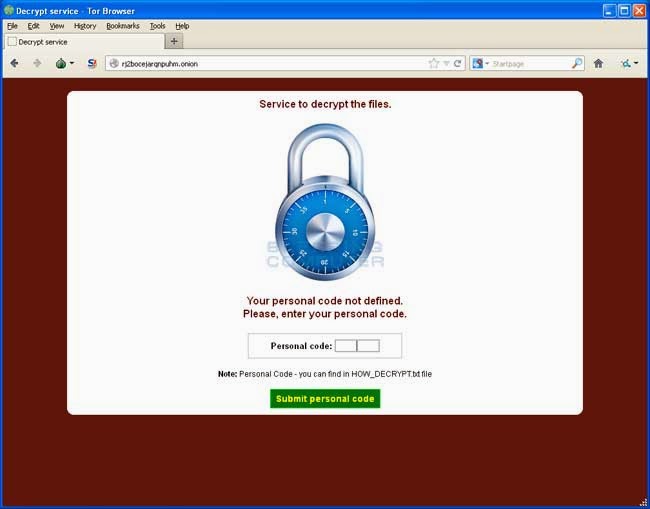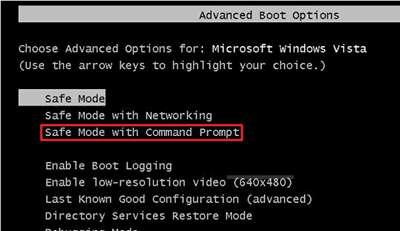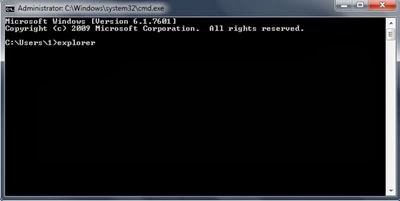Name of Threat: CryptoDefense
Severity: High
Affected OS: Windows 7, XP, Vista, 8
What is CryptoDefense?
CryptoDefense is considered as a new variant of CryptoLocker, typical ransomware which mainly attack a targeted computer by forcibly restricting the access to affected Windows and encrypting data stored on hard drive. Till now, it has the capability to attack all versions of Windows; no matter you are using Windows 7, XP, Vista or Windows 8. Some templates of CryptoDefense may also hijack user’s browser, regardless of IE/Chrome/Firefox, and display its How_Decrypt.html or How_Decrypt.txt on the screen for the purpose of threatening PC users. When your PC is infected with this ransomware, it will immediately encrypt all files including videos, photos and documents on your computer.
The encryption technique CryptoDefense uses is the unique public key RSA-2048 which can only be decrypt with a private key. To unlock PC and decrypt your files, CryptoDefense scam will demand you to pay a ransom about $500 USD in Bitcoins. However, even though you pay for the required fee, CryptoDefense may still come back over and over again.Tricky as CryptoDefense is, it typically delete all Shadow Volume Copies for the purpose of avoiding files from the Shadow Volumes. Without timely removal, CryptoDefense ransomware may even open a backdoor for remote hackers, and thus potentially lead to further compromise for other attackers. This may directly lead to worse results in affected computer as well as your privacy. Thus, it is urgent to get rid of CryptoDefense scam as fast as you can to avoid any unwanted damage or data loss.
Take A Look on CryptoDefense


How to Recognize CryptoDefense Symptoms
- You are not allowed to access the computer’s desktop for the screen was locked up by the ransomware virus.
- CryptoDefense encrypts all files stored on your computer, including text files, image files, video files, and office documents.
- You are unable to access the Internet.
- Safe mode may also be disabled by the CryptoDefense virus.
- System Restore may be deleted by the virus that you are unable to recover your computer via System Restore point.
Why does My Antivirus Cannot Stop CryptoDefense?
Most of the time, major PC users prefer to safeguard their computer and prevent from potential threats with their trusted antivirus. However, even though you have the top antivirus program installed, the CryptoDefense virus still gets through without your consent. You may ask why. I should say there is actually no such thing as perfect protection. Virus is created every day. Such virus like the CryptoDefense is designed to have been changed the code so antivirus can’t keep up. Once executed, CryptoDefense virus can disable your security tool. In such circumstance, manual removal is required.
How to Remove CryptoDefense Scam Manually
1. Safe Mode with Command Prompt.
For Windows XP, Vista, Win7:
Start up your computer. Keep pressing F8 constantly before Windows launches. Then the Window Advanced Option menu will appears, highlight the cursor and choose Safe Mode with Command Prompt.

For Windows 8:
- Start your computer, hold down the Shift key and hit the F8 key (Shift+F8) repeatedly. The Recovery Mode Window would pop up, choose the option of See advanced repair options.
- The Choose an option screen will appear, choose the Troubleshoot option to continue.
- You will get there options in the Troubleshoot Window, click on or select the Advanced Options.
- Now the Window Startup Settings option will come up. Click on Restart Button to continue.
- Here, you will get the Advanced Boot Options that involved with Safe Mode with Command Prompt.
- Highlight the Safe Mode with Command Prompt option or press number key 6 to enable Safe Mode with Command Prompt.
2. When the CMD (cmd.exe) Window pops up, type explorer and press Enter. Later, you will be able to see the desktop.

3. Open Registry Editor (in Windows XP, go to Start Menu, run, type in “Regedit” and press OK; in Windows 7, Windows Vista & Windows 8, go to Start menu, Search, type in “Regedit”), find out the following CryptoDefense registry entries and delete:

HKEY_CURRENT_USER\Software\Microsoft\Windows\CurrentVersion\Random “.exe”
HKEY_CURRENT_USER\Software\Microsoft\Windows\CurrentVersion\Run\[RANDOM CHARACTERS].exe
HKEY_LOCAL_MACHINE\Software\Microsoft\Windows NT\CurrentVersion\Random
HKEY_LOCAL_MACHINE\SOFTWARE\Microsoft\Windows\CurrentVersion\policies\Explorer\run\Random.exe
4. Remove all the files of CryptoDefense, such as:
%AllUsersProfile%\random.exe
%Temp%\random.exe
%AllUsersProfile%\Application Data\.dll
Attention: Manual removal is known as the best way to get rid of CryptoDefense infection. However, it requires certain computer tech knowledge to deal with key parts of system files. If you are not familiar with the operation and do no want to make mistake, it is recommended to ask help from VilmaTech 24/7 Online Experts to resolve your problem in few minutes.


Are you willing to know who your spouse really is, if your spouse is cheating just contact cybergoldenhacker he is good at hacking into cell phones,changing school grades and many more this great hacker has also worked for me and i got results of spouse whats-app messages,call logs, text messages, viber,kik, Facebook, emails. deleted text messages and many more this hacker is very fast cheap and affordable he has never disappointed me for once contact him if you have any form of hacking problem am sure he will help you THANK YOU.
ReplyDeletecontact: cybergoldenhacker at gmail dot com